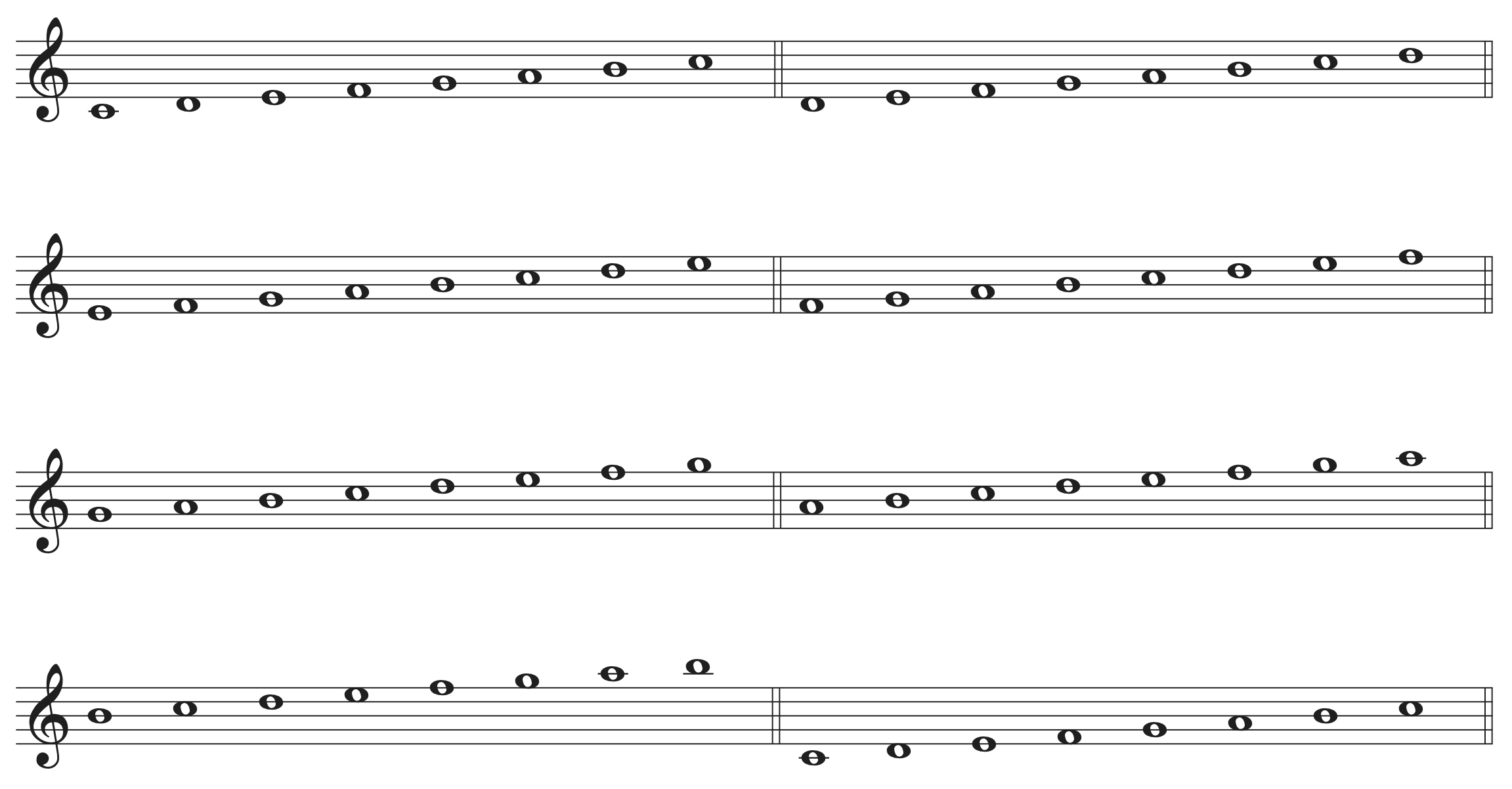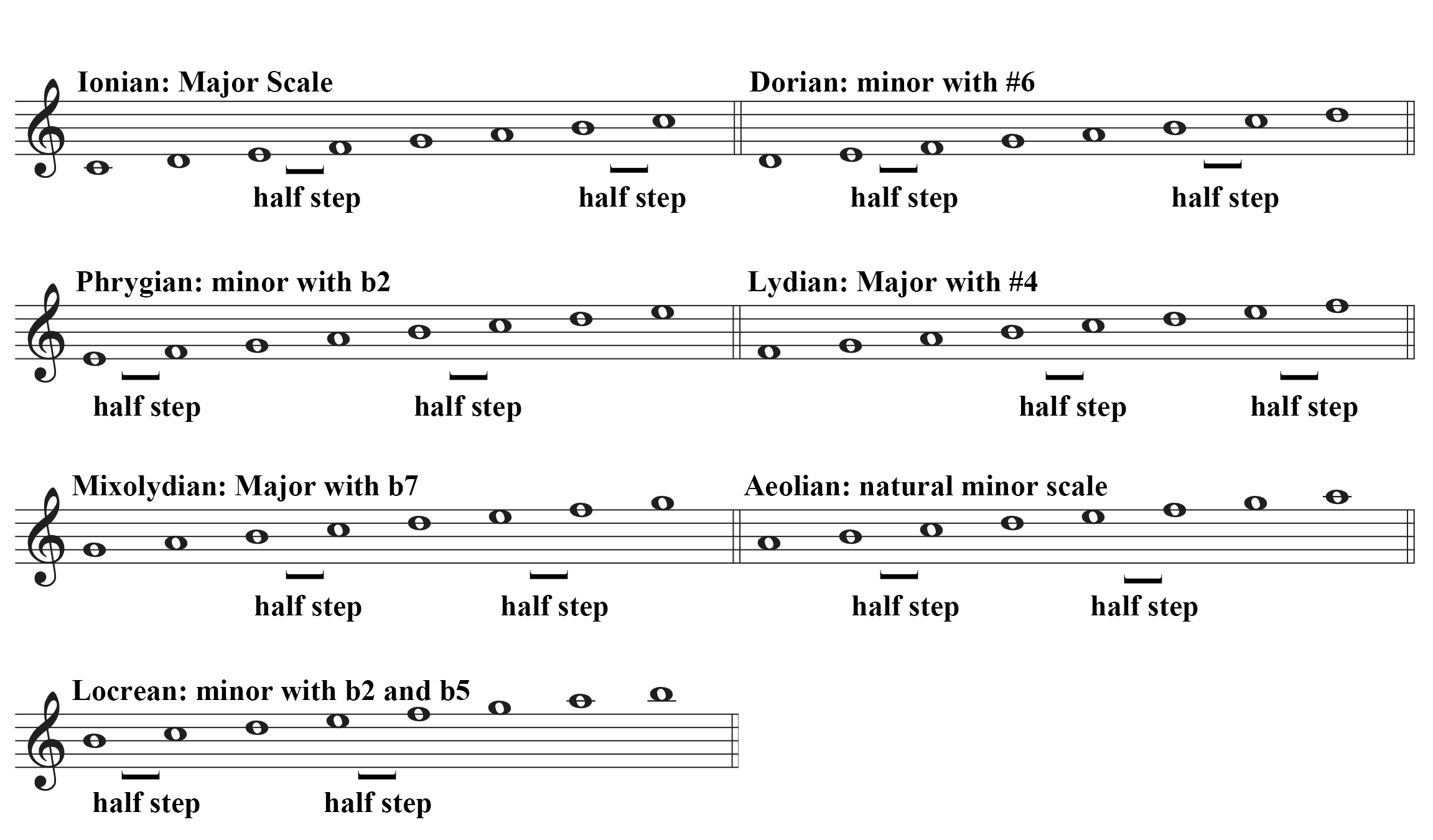3.4 Modal Scales: Tutorial
Modal Scales
Early music contained no accidentals. It only included the white keys on the piano: C D E F G A B. How did composers write music that didn’t all sound the same? Instead of keeping the same pattern of whole and half steps and transposing the scale so that it started on different tonics, like we do in order to change keys, composers kept the same notes, but changed which note started the scale. This resulted in scales that only used those same 7 pitches but changed the order of whole and half steps in each scale. These scales were called modal scales and were given Greek names. In the picture below, you can see the 7 modal scales.

We group modes into 2 categories: the major modes and the minor modes. The major modes are most closely related to the major scale, but contain alterations. The major modes include Ionian (which is the same as a major scale); Lydian, which is like a major scale with a raised scale degree 4; and Mixolydian, which is like a major scale with a lowered scale degree 7. The minor modes are most closely related to the natural minor scale, but contain alterations and include: Phrygian, which is like natural minor with lowered scale degree 2; Dorian, which is like natural minor with raised scale degree 6; Aeolian, which is the same as a natural minor scale; and Locrean, which is like a natural minor scale with lowered scale degrees 2 and 5.

Modal Scale Function and Use in Music
Due to the variable placement of half steps in the scale, modal scales do not function like major and minor keys. They do not have the same functional relationship between scale degrees. As a results, modal scales sound different than major and minor scales.
Over time, accidentals were introduced and modal scales could be transposed to start on any pitch. Composers choose to write music using modal scales due to the unique nature of the sound of each mode. Let’s look at the modes in order of brightest to darkest.
Lydian is the brightest of the modes because it is based on a Major scale with a raised scale degree 4. It hardly has any dissonance because it sounds like Major with a missing half step between scale degrees 3 and 4. It is used in dreamy compositions without a strong sense of motion because of its bright sound and lack of direction due to the missing expected half step in a Major scale.
Lydian Scale:
Oceans by Pearl Jam features the Lydian mode.
Ionian is the next brightest mode and is the same as a Major scale. It has the expected “happy” Major sound.
Ionian scale:
Free Fallin’ by Tom Petty is an example of Ionian.
Mixolydian is slightly darker and more unstable than major and lacks the directional push from leading tone to tonic.
Mixolydian scale:
Norwegian Wood by the Beatles features the Mixolydian mode.
Dorian is the brightest of the minor modes due to its raised scale degree 6. It is often used in folk music and creates harmonies that do not sound as sad as minor.
Dorian scale:
Scarborough Fair by Simon & Garfunkel is built around the Dorian mode.
Aeolian is the same as the natural minor scale and has the expected “sad” minor sound.
Aeolian scale:
Losing My Religion by R.E.M. is an example of Aeolian.
Phrygian is a darker version of the natural minor scale. It creates an edgier version of minor and is often used in compositions that need a darker character.
Phrygian scale:
Pyramid Song by Radiohead is built around the characteristic flat scale degree 2 sound of the Phrygian mode.
Locrean is the darkest of the modes and sounds unstable. Music written in this mode always sound like it needs to resolve to a different tonic note due to its half step placements. It also includes a dissonant interval between scale degree 1 and 5 and a diminished chord built on its tonic. Due to its instability and tendency to sound unresolved, it is used more for special effect in a piece rather than for the basis on a full composition.
Locrean scale:
The intro of Rush’s YYZ uses the Locrean scale.
Listen to examples of modal pieces and think about how they sound different from pieces written in Major or minor keys. Were there pieces listed above that you didn’t realize were written in modes instead of keys? If you were to write a song in each mode, what lyrics might you use to highlight the specific quality of each mode?

